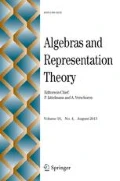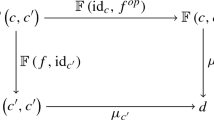Abstract
By a theorem of Majid, every monoidal category with a neutral quasi-monoidal functor to finitely generated and projective \(\Bbbk \)-modules gives rise to a coquasi-bialgebra. We prove that if the category is also rigid, then the associated coquasi-bialgebra admits a preantipode, providing in this way an analogue for coquasi-bialgebras of Ulbrich’s reconstruction theorem for Hopf algebras. When \(\Bbbk \) is a field, this allows us to characterize coquasi-Hopf algebras as well in terms of rigidity of finite-dimensional corepresentations.
Similar content being viewed by others
References
Abe, E.: Hopf Algebras Cambridge Tracts in Mathematics, vol. 74. Cambridge University Press, Cambridge (1980)
Aguiar, M., Mahajan, S.: Monoidal Functors, Species and Hopf Algebras CRM Monograph Series, vol. 29. American Mathematical Society, Providence (2010)
Ardizzoni, A., Bulacu, D., Menini, C.: Quasi-bialgebra structures and torsion-free abelian groups. Bull. Math. Soc. Sci. Math. Roumanie (N.S.) 56(104), 3,247–265 (2013)
Ardizzoni, A., El Kaoutit, L., Saracco, P.: Functorial constructions for non-associative algebras with applications to quasi-bialgebras. J. Algebra 449, 460–496 (2016)
Ardizzoni, A., Pavarin, A.: Preantipodes for dual Quasi-Bialgebras, Israel. J. Math. 192(1), 281–295 (2012)
Ardizzoni, A., Pavarin, A.: Bosonization for dual quasi-bialgebras and preantipode. J. Algebra 390, 126–159 (2013)
Deligne, P., Milne, J. S., Ogus, A., Shih, K.-y.: Tannakian categories. In: Milne, J.S. (ed.) Hodge Cycles, Motives, and Shimura Varieties by Pierre Deligne. Lecture Notes in Math. 900, Springer (1982)
Drinfel’d, V. G.: Quasi-hopf algebras. (Russian) Algebra Anal. 1(6), 114–148 (1989)
Drinfel’d, V. G.: Translation in Leningrad. Math. J. 1(6), 1419–1457 (1990)
El Kaoutit, L., Gómez-Torrecillas, J.: Infinite comatrix corings. Int. Math. Res. Not. 39, 2017–2037 (2004)
Gómez-Torrecillas, J., Vercruysse, J.: Comatrix corings and Galois comodules over firm rings. Represent. Theory 10(3), 271–306 (2007)
Häring-Oldenburg, R.: Reconstruction of weak quasi Hopf algebras. J. Algebra 194(1), 14–35 (1997)
Joyal, A., Street, R.: An introduction to Tannaka duality and quantum groups. Category theory (Como, 1990), 413-492, Lecture Notes in Math, vol. 1488. Springer, Berlin (1991)
Majid, S.: Foundations of Quantum Group Theory. Cambridge University Press, Cambridge (1995)
Majid, S.: Tannaka-Kreı̆n Theorem for quasi-Hopf Algebras and Other Results. Deformation Theory and Quantum Groups with Applications to Mathematical Physics (Amherst, MA, 1990), 219–232, Contemp Math 134. Amer. Math. Soc., Providence (1992)
Mac Lane, S.: Categories for the Working Mathematician. Second Edition Graduate Texts in Mathematics, vol. 5. Springer, New York (1998)
Saavedra Rivano, N.: Catégories Tannakiennes. Springer LNM 265 (1972)
Saracco, P.: On the structure theorem for Quasi-Hopf bimodules appl categor struct. https://doi.org/10.1007/s10485-015-9408-9 (2015)
Schauenburg, P.: Hopf algebra extensions and monoidal categories. New directions in Hopf algebras, vol. 43, pp. 321–381, Math. Sci. Res. Inst. Publ., Cambridge Univ. Press
Schauenburg, P., bimodules, Hopf: Coquasibialgebras, and an exact sequence of Kac. Adv. Math. 163, 194–263 (2002). Cambridge
Schauenburg, P.: Tannaka Duality for Arbitrary Hopf Algebras Algebra Berichte [Algebra Reports], vol. 66. Verlag Reinhard Fischer, Munich (1992)
Schauenburg, P.: Two characterizations of finite quasi-Hopf algebras. J. Algebra 273(2), 538–550 (2004)
Street, R.: Quantum groups. A Path to Current Algebra Australian Mathematical Society Lecture Series, vol. 19. Cambridge University Press, Cambridge (2007)
Sweedler, M. E.: Hopf algebras. Mathematics Lecture Note Series, W. A. Benjamin, Inc., New York (1969)
Ulbrich, K. H.: On Hopf algebras and rigid monoidal categories. Israel J. Math. 72, 252–256 (1990)
Acknowledgments
This paper was written while the author was member of the ”National Group for Algebraic and Geometric Structures and their Applications” (GNSAGA-INdAM). The author is sincerely grateful to Alessandro Ardizzoni and Claudia Menini for their contribution and to the referee for her/his useful suggestions.
Author information
Authors and Affiliations
Corresponding author
Additional information
Presented by: Michel Van den Bergh
Publisher’s Note
Springer Nature remains neutral with regard to jurisdictional claims in published maps and institutional affiliations.
Appendix A: A relation for the preantipode of a quasi-bialgebra
Appendix A: A relation for the preantipode of a quasi-bialgebra
Recall from [18] that a preantipode for a quasi-bialgebra (A, Δ, ε, m, u, Φ) is a \(\Bbbk \)-linear map S : A → A that satisfies
for all a,b ∈ A, where \(\sum {\Phi }^{1}\otimes {\Phi }^{2}\otimes {\Phi }^{3}={\Phi }\). Let us introduce also the following extended notation for the reassociator and its inverse:
Let (A,m,u,Δ,ε,Φ,S) be a quasi-bialgebra with preantipode and consider the A-actions on End(A) = Hom(A,A) defined by \(\left (f\leftharpoonup a\right )(b) = f(ab)\) and \(\left (a\rightharpoonup f\right )(b) = f(ba)\) for all a,b ∈ A and for all f ∈EndA. Define the elements
where \(\left (x\left (y\rightharpoonup f\right )\right )(a) = xf(ay)\) and \(\left (\left (f\leftharpoonup x\right )y\right )(a) = f(ax)y\) for all a,x,y ∈ A and for all f ∈EndA. Let us introduce the following notation for shortness:
Lemma.
In the foregoing notation we have that for every a ∈ A
Moreover, the following relations hold for every a,b ∈ A
Proof
The reassociator Φ satisfies the dual relation to Eq. 3, i.e.
In particular, it satisfies
Applying \(\left (A\otimes m\right ) \left (A\otimes A\otimes m\right ) \left (A\otimes A\otimes (S\leftharpoonup a)\otimes A\right ) \) to both sides we get
which is the first identity in Eq. 33. The second one is proved analogously. Let us check that Eq. 34 holds as well ((35) is proved similarly). We compute
where in (∗) we used the quasi-coassociativity Φ ⋅ (Δ ⊗ A)Δ = (A ⊗Δ)Δ ⋅Φ. □
Lemma.
Let (A,m,u,Δ,ε,Φ,S) be a quasi-bialgebra with preantipode and let p,q be defined as above. For all a ∈ A we have that
Proof
Keeping in mind that Φ− 1 is counital, i.e. that it satisfies
we may compute directly
□
Proposition.
Let (A,m,u,Δ,ε,Φ,S) be a quasi-bialgebra with preantipode. For all a,b ∈ A we have
Proof
We know from Lemma A.2 that \(S(a)=\sum q^{1}\left (1_{A}\right )S\left (p^{1}aq^{2}\right ) p^{2}\left (1_{A}\right )\). Relation (36) is proved directly by applying it to \(S\left (ab\right ) \):
□
Formula (36) can be viewed as an anti-multiplicativity of the preantipode.
Rights and permissions
About this article
Cite this article
Saracco, P. Coquasi-Bialgebras with Preantipode and Rigid Monoidal Categories. Algebr Represent Theor 24, 55–80 (2021). https://doi.org/10.1007/s10468-019-09931-2
Received:
Accepted:
Published:
Issue Date:
DOI: https://doi.org/10.1007/s10468-019-09931-2



